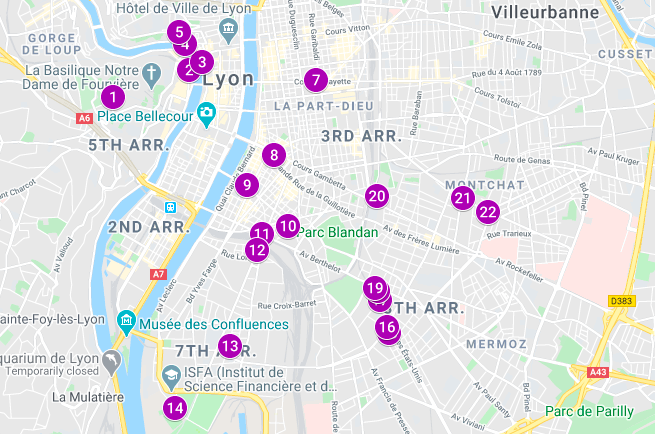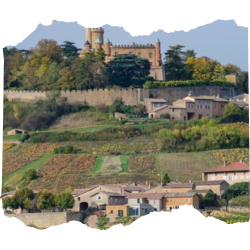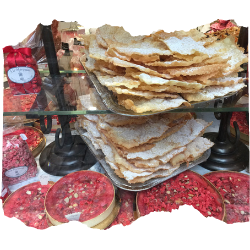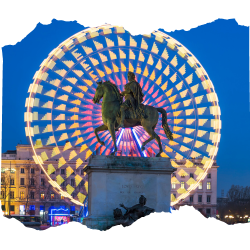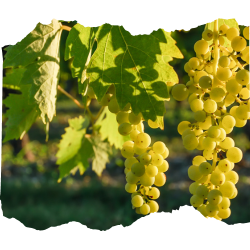Unsure about your French table manners? Click Here to download > > How to avoid these 10 food etiquette mistakes !
- Home ›
- Destinations ›
- Lyon ›
- Lyon Murals
Lyon Murals: Monumental Naïve Art in Public places
Updated 24 July 2025 by Leyla Alyanak — Parisian by birth, Lyonnaise by adoption, historian by passion
Lyon's amazing murals offer a unique glimpse into the city's artistic soul, turning ordinary walls into extraordinary art. This article guides you through the most iconic murals in Lyon – and tells you where to find them.
The first time I saw this most famous of Lyon murals (part of it is reproduced above) I blinked — it took a second or two to realize it was a painting, not a live scene.
Please keep staring, because it might take you a minute to distinguish what's real from what is created. Visiting some of Lyon's 200 murals is without a doubt one of best things to do in Lyon.
NOTE: Pages on this site may contain affiliate links, which support this site. See full Privacy Policy here.
Lyon is a city that is full of surprises and its giant murals are just the tip of the iceberg.
What follows are some of the most spectacular (including my own personal favorites because no, there's nothing impartial about this list).
Lyon is already one of the prettiest cities in France, and these murals provide an unusual and offbeat look at this splendid city.
Going from one mural to the next will require transport. If you're planning on being in Lyon a day or more, consider getting a City Card Lyon, for free entry into the city's museums, several guided tours, and free transport all day long.
Some of the most spectacular frescoes of Lyon
To locate the most famous art murals, I've added the top murals of Lyon to the map below. Just click the map (the numbers on the map correspond to the descriptions on the list below).
Lyon murals map
This map of Lyon murals locations is a guideline. Addresses are accurate, but map markers are approximate. Use them to navigate neighborhoods rather than pinpoint specific façades.
Best Murals in Old Lyon, Croix-Rousse and other central locations
La Sarra (1)
8 rue Pauline Jaricot, Lyon 5
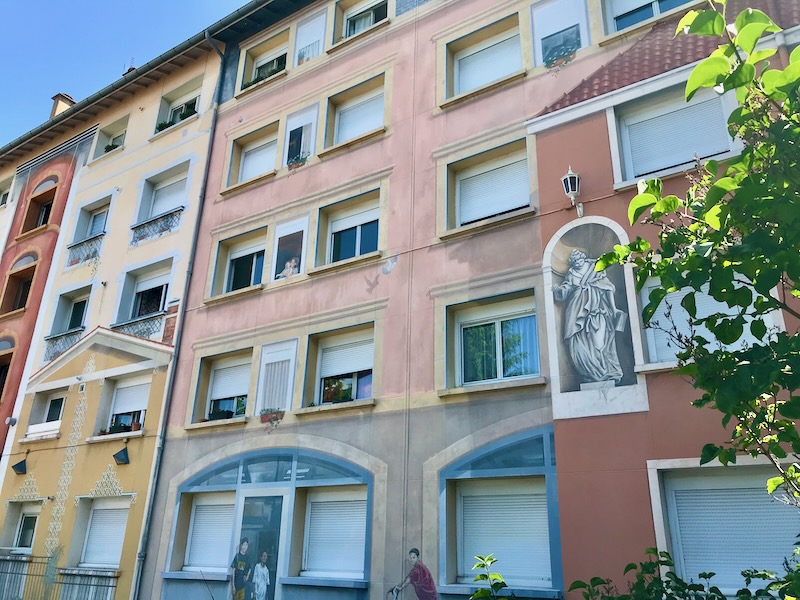 Try to imagine what this looked like with no colour or texture or designs... this is classic street art Lyon created by Cite-Creation, who specialize in this type of artwork
Try to imagine what this looked like with no colour or texture or designs... this is classic street art Lyon created by Cite-Creation, who specialize in this type of artworkIt's hard to believe this was once a pale, nondescript wall of the Cité La Sarra, government housing in a middle-class neighborhood not far from the city's Roman ruins.
Today, this example of Lyon street art is considered the world's largest architectural trompe l'oeil, an art form that tricks you into thinking that what you're seeing is real — like those colourful awnings and balconies.
The designs are painted on the front of four long buildings. These formerly pale, cookie-cutter façades now jump with color, covered in faux stone work and marble swirls and balustrades, awnings and fake roofs pulling from Roman, Medieval and Renaissance eras.
They give the impression of a series of small, coquettish residences rather than the residential behemoth it actually is.
🎨
Cour des Loges (2)
Place Ennemond Fousseret, Lyon 5
This large wall depicts an intriguing scaffolding, which is being used to change sets in a theater during a play — except it's not. But it is so well done you'd be forgiven for thinking it was real. The wall now belongs to a hotel of the same name.
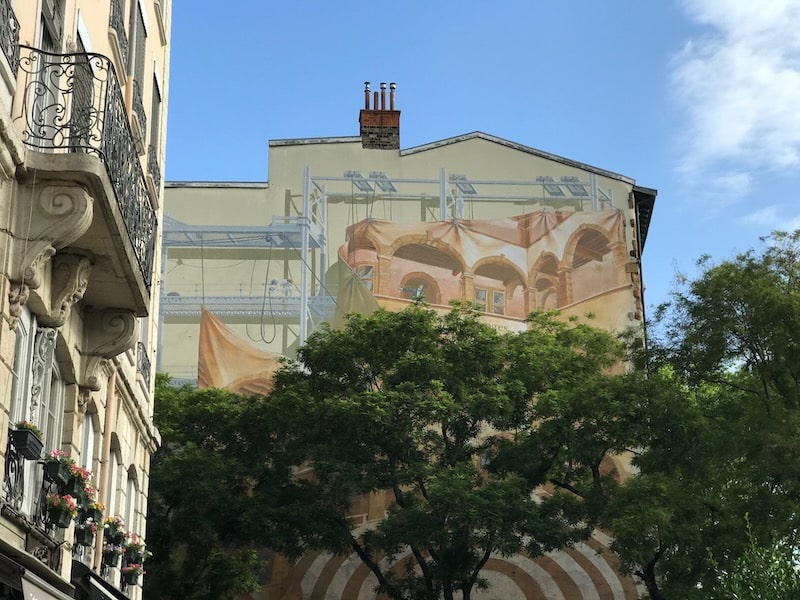
➽ YOU CAN ACTUALLY STAY HERE!
The Cour des Loges is a high-end luxury hotel located in Lyon's most historic district, Old Lyon, within walking distance of all major Lyon must-see attractions. Plenty of character and romance! CLICK HERE FOR PRICES AND AVAILABILITY.
🎨
Mur des Écrivains aka Bibliothèque de la Cité (3)
Corner of rue de la Platière and quai de la Pêcherie, Lyon 1
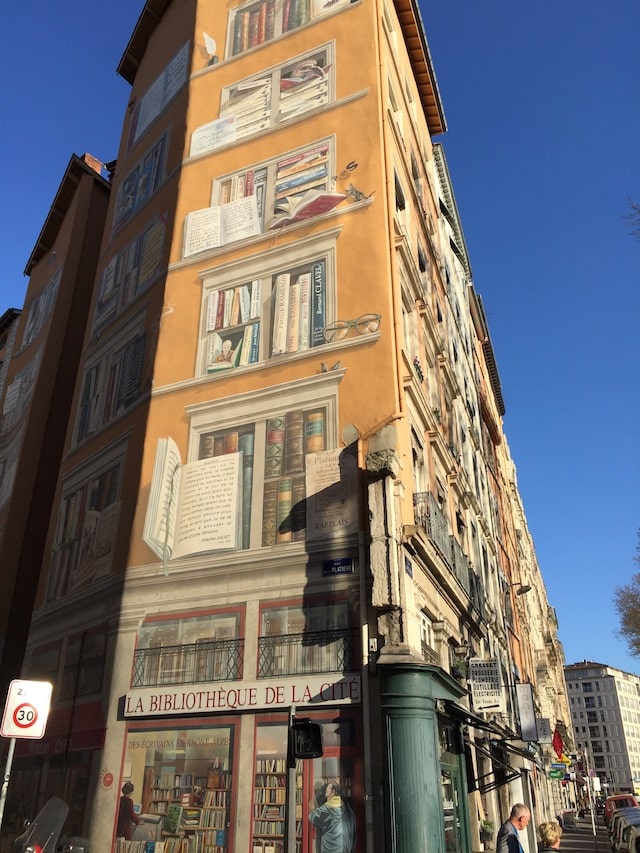 Creative Lyon art at its best: bookshop mural, Lyon
Creative Lyon art at its best: bookshop mural, LyonThis spectacular mural, the Wall of Writers, represents the works of some 300 local writers, many of them familiar to me — I just didn't know they were from Lyon.
Many of them are national cultural icons, like Frédéric Dard, author of the gumshoe San Antonio series. Others are internationally famous, like Antoine de Saint-Exupéry, who wrote The Little Prince.
🎨
La Fresque des Lyonnais and Le Pot Beaujolais (4)
49, quai Saint-Vincent and 2, rue de la Martinière, Lyon 1

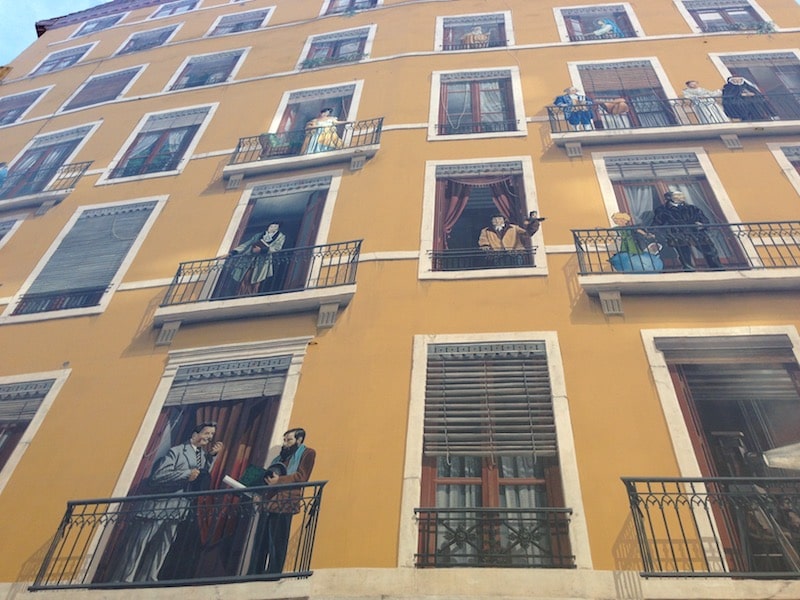 One of the best-loved murals - Lyon France
One of the best-loved murals - Lyon FranceThis giant fresco is definitely one of those you must see if you're tracking Lyon's painted walls. It covers the entire front of a large building and there's every chance that if you're ambling around central Lyon and the Saône River, you'll come upon it.
I photographed it from the front, looking up, with predictable results. To get a better vantage point, pull back to capture the entire building, and catch 30 or so famous people from Lyon, luminaries like Chef Paul Bocuse or the Lumière brothers, who invented the first motion picture camera.
It's divided into two parts, with the lower street level dedicated to shops and restaurants, as in real life, and the rest of the building re-creating an apartment, with balconies and local celebrities occupying them. This may well be my favorite Lyon mural.
Across the street, at 7 rue Pareille, you'll find a homage to 19th-century painter Tony Tollet.
🎨
Le Mur des Canuts (6)
36 Boulevard des Canuts, Lyon 4
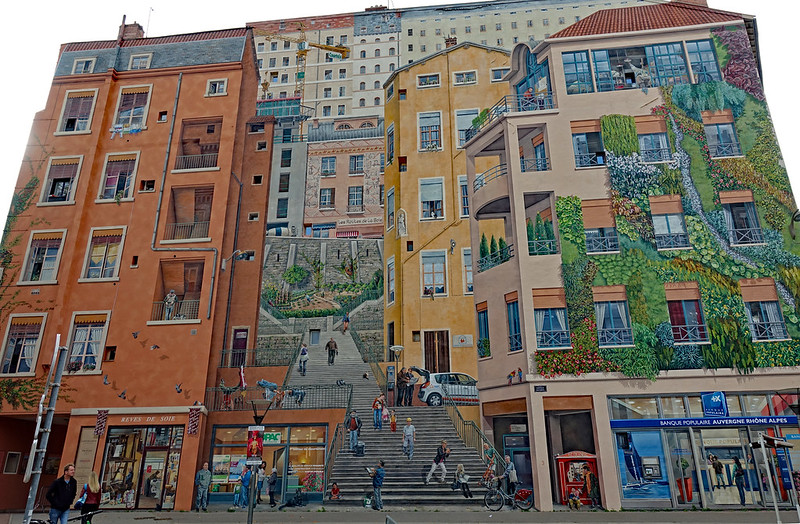 The Mur des Canuts in its glorious entirety (photo by Allie Caulfield via CC 2)
The Mur des Canuts in its glorious entirety (photo by Allie Caulfield via CC 2)This photograph amplifies the one at the top of the page: it shows you the entire Mur des Canuts, as opposed to the close-up I provided at the beginning of this story. (I do need to get a camera with actual lenses...)
A canut is a silk worker and the neighborhood, Croix-Rousse, is where all the silk weavers' workshops were once located.
Not only is it huge, but it is spectacular and spellbinding, the kind of art that makes you stop and explore. No wonder it is the most famous in Lyon, not to mention the city's first monumental trompe-l'oeil.
It portrays a day in the life of Croix-Rousse, with its buildings, ubiquitous stairways and small businesses. It is overwhelming by its very ordinaryness, by the routine it portrays.
What you might not know about this mural is that it is repainted every decade or so to reflect local changes.
It's hard to imagine that this was once a blank wall... and yet... If there is a single mural you should see when you visit Lyon, this is it.
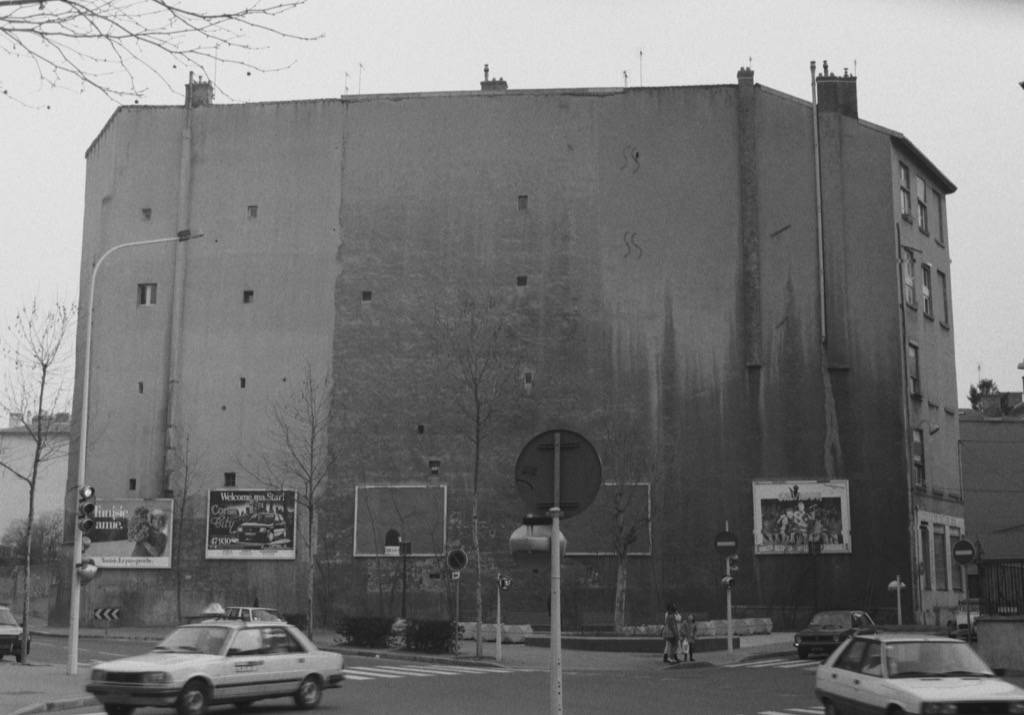 The Mur des Canuts, before being painted by Cité-Création (Photo Cité-Création)
The Mur des Canuts, before being painted by Cité-Création (Photo Cité-Création)ALSO READ: Croix-Rousse, Home of Lyon's Silk Workers
🎨
Thank You Monsieur Paul (7)
103 Cours Lafayette, Lyon 2
The late Paul Bocuse, the most hallowed name in French gastronomy, has left his mark all over Lyon, including in the covered market, Les Halles Paul Bocuse, that bear his name.
To honor Bocuse, a fresco was painted just across the street from Les Halles and fills the entire side of a building. At night, the lights come on and shine on the words "Thank You Monsieur Paul", which turn into a nine-minute video!
Bocuse is so famous he also has a central role in the delightful "Fresque des Lyonnais" I mentioned above.
🎨
Le Mur du Cinéma (8)
18 Cours Gambetta, Lyon 7
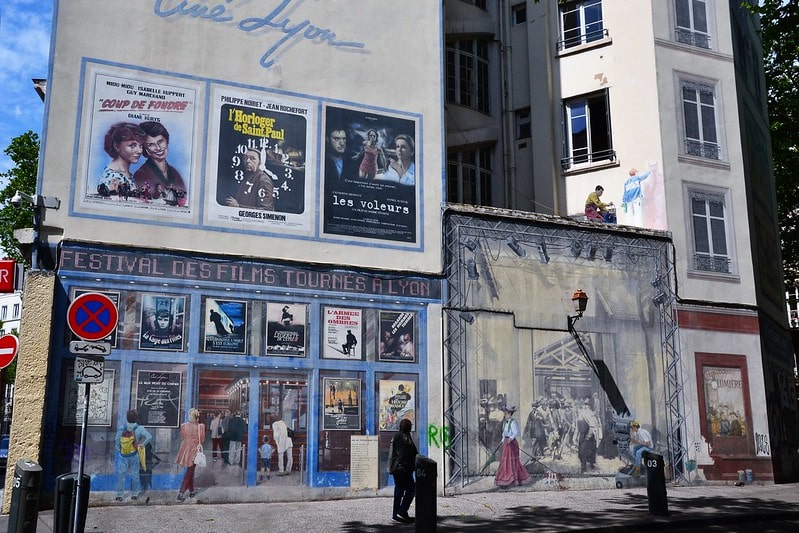 The charming Mur du Cinéma, or Cinema Wall (photo by Jeanne Menjoulet via CC 2)
The charming Mur du Cinéma, or Cinema Wall (photo by Jeanne Menjoulet via CC 2)This fun fresco looks like the entrance to a cinema — except it is a trompe l'oeil. The mural shows a film being shot on a movie set, as well scenes from the first film ever made. Additional nostalgia is provided by portraying one of the Lumière brothers and movie posters from past films. A slice of cinematic history in Lyon...
🎨
Travel to Lyon is easiest by bus or train. Check prices and schedules here.
Les murs de Gerland
The following four famous mural paintings are part of the walls of Gerland, in Lyon's 7th arrondissement, or district.
Fresque Lumière (12)
106 avenue Jean Jaurès, Lyon 7
Not to be confused with the plant-based fresco also called Lumière (a popular name in Lyon – the Lumière brothers, credited with inventing motion pictures, were born and raised here), this particular fresco is a dazzling creation that predicts Lyon in 2046. Beautiful during the day, the futuristic lights go on at night.
🎨
Espace Diego Rivera (13)
19-25 rue Georges Gouy, Lyon 7
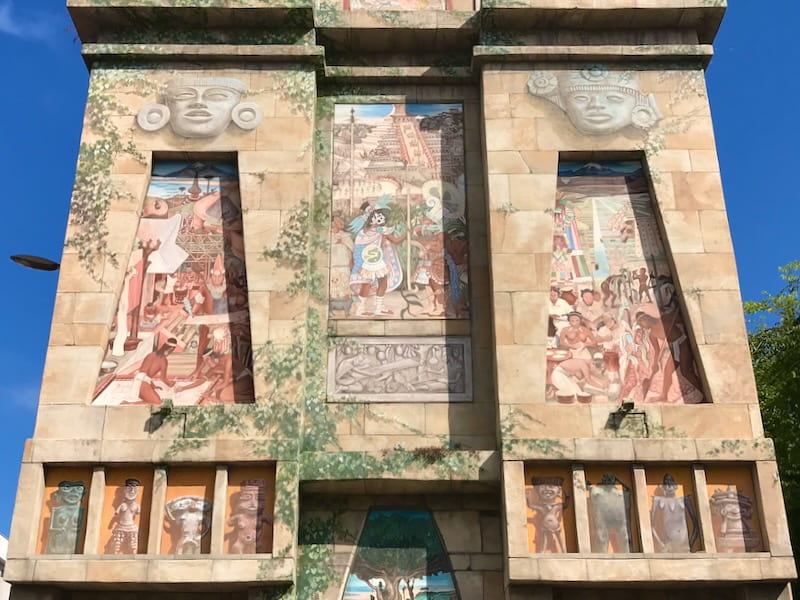
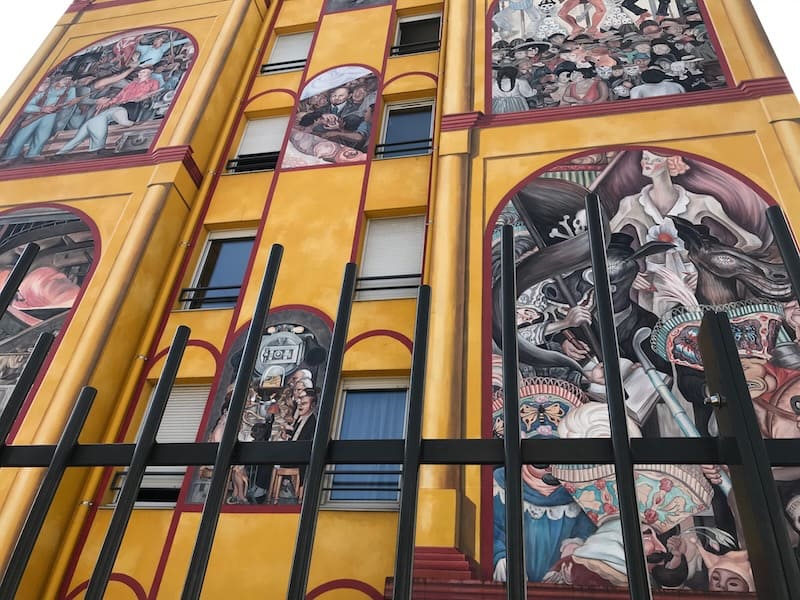
An illuminated triptych represents Mexico's history as seen by the Mexican artist Diego Rivera, considered the father of large-scale murals.
The story starts with Aztec and Mayan civilizations, then traces the Spanish military conquest, the enslavement of indigenous people and modern social change in Mexico. Here's a 360° view of it!
🎨
TIRED OF WALKING?
Take a rest from viewing murals with this one-hour sightseeing cruise along the Saône River, in the heart of Lyon. BOOK YOUR CRUISE HERE!
Fresque de Gerland (14)
16-18 rue Pierre de Coubertin, Lyon 7
This mural covers the entire side of a building and highlights the neighbourhood's activities — including France's 1998 World Cup victory, but I have yet to visit this one.
🎨
Quartier des Etats-Unis (USA neighbourhood)
This group of frescoes is interesting not only because of their quality but because they highlight the typical approach to these urban murals — consultation with local communities. These are produced on low-rent housing estates, known as HLM, or Habitations à Loyer Modéré.
Tony Garnier Urban Museum (15)
A most unusual outdoor complex, this urban museum has 30 frescoes by CitéCréation (the cooperative which designed and painted some of Lyon's most famous murals) that highlight the futuristic vision of Tony Garnier, a renowned architect and urban planner.
The frescoes illustrate five continents and include paintings by artists from Cote d'Ivoire, Egypt, India, Russia and the United States. These too are painted on the walls of low-rent housing and were designed by Garnier as part of his utopic vision for a modern industrial society.
But that was in the early 20th century and by the 1980s the area had deteriorated. Residents called in CitéCréation, with a plea for help and a desire to rehabilitate the neighbourhood. It worked and the mural is now the pride of locals.
🎨
Les Cités Idéales
- Ideal City of Quebec (16) at the corner of rue Paul Cazeneuve and the Boulevard des Etats-Unis, created to celebrate Quebec's 400th anniversary.
- Shanghai Fresco (17) and
- the Towers of Babel (18 and 19) on Place Mendès France.
🎨
A few more famous Lyon murals
- Fresque Végétale Lumière (5), Rue de l'Annonciade, Lyon 1. This intriguing fresco or modern wall painting is different from most: it combines several mural paintings with vertical vegetation, large strips of plants that separate each painting. All of it is lit up — hence the use of the word lumière, which also happens to mean light in French.
- La Fresque Art Déco Targe (9), 50 rue de Marseille, Lyon 7. This is a more unusual topic for a fresco — the Targe mirror store. But the shop's quintessential Art Deco architecture makes it a little jewel to look at.
- Agir pour la biodiversité LPO, or Conserve Biodiversity (10), 87 rue Chevreul, Lyon 7. This mural highlights the need to take action to conserve biodiversity by picturing the animals and plants of Lyon.
- Public Transport Fresco (22), 98 Avenue Lacassagne, Lyon 3. This one tells the story of transport in Lyon, from the first horse-drawn carriage to the subway.
- Routes de la Soie (Silk Roads) Clos Jouve, Lyon 1. Here you'll find reminders of 3000 years of the history of the Silk Road, which started in Asia and made its way to Europe, into Lyon, helping turn the city into a prosperous silk-manufacturing hub.
- Centennial Fresco or Fresque du Centenaire (11), Avenue Berthelot, Lyon 7. This series of paintings tells the story of the 7th arrondissement of Lyon and is spread out under the arcades of the railway tracks that follow the avenue.
- Fresque de Montluc (20), rue du Dauphiné, Lyon 3.
- Lyon, la santé, la vie "health and life" (21), 115 avenue Lacassagne, Lyon 3.
Quick video of some Lyon murals
How did Lyon become the capital of murals in France and beyond?
Lyon may be known around the world as the capital of gastronomy, but it now wears a second capital city hat: the capital of murals. (While Vitry-sur-Seine and Boulogne-sur-Mer are also known for urban mural art, Lyon is unique for its scale and technique (trompe l’œil).
Frescoes as an art form have been around as long as we humans — think prehistoric cave paintings, in which our ancestors decorated the walls of their rock dwellings or shelters. In a way, today's mural artists see themselves as their descendants.
It seems we all like to paint our walls: Egyptians painted the walls of their tombs, Romans decorated their temple walls, clerics in the Middle Ages adorned their churches (many people were illiterate and the drawings were like stories that helped pass on knowledge).
The particular technique known as trompe l'oeil — or deceiving the eye — became hugely popular in the 17th and 18th centuries. Like most things that fall in and out of fashion, they disappeared for a while but resurfaced with a vengeance in the late 20th century.
It all seems to have started in 1978, when a group of nine students rebelled against the School of Fine Arts' elitism and minimalism — they wanted to get their hands dirty and do art for the people. They left school and created a popular association, Populart, to bring art to poorer neighbourhoods.
They could not have chosen a better time: Lyon back then was dark and dingy, a bit like Bordeaux before its facelift. Pretty much the city's only claim to fame was Paul Bocuse.
On a study trip to Mexico, inspired by the work of Diego Rivera, the students learned to paint monumental murals based on people's stories and experiences.
Later, back in France, they began to decorate buildings both in poorer parts of town but also right in the center and in wealthier neighborhoods. And that's how, in 1986, the CitéCréation mural painting cooperative was born.
Their first monumental creation, the Mur des Canuts, was quickly followed by the Fresque des Lyonnais. Eventually, they mapped a path through the frescoes, creating the first ever "wall mural tour", which has become one of Lyon's top visitor draws (you can use the map above to help guide you).
Their work was so successful the cooperative began receiving commercial contracts and was hired to paint murals all over town for businesses.
But when it came to residential frescoes, ideology trumped commerce: local residents would always be involved in the planning of a mural; they had to live with the designs, after all.
This is, peculiarly, art that doesn't come from an artist's inner vision and inspiration. Instead, the inspiration is from the outside, from community needs and collective memory. Artists work with outside materials that don't belong to them — people's homes — and what counts for them is to be at the service of a community. They also meet extensively with local people to understand their wants and needs.
An important factor: the coop employs as many women as men. It's in their statutes, and a majority of their artists are women.
The coop has now become international, with mural creations all over the world including Germany, Spain, Portugal, Morocco, Quebec and South Korea. It even opened the world's first mural art school in Lyon, which teaches not only art techniques but insists on integrating them into the social fabric of the community.
This work has paved the way for other mural creators, who have also opened their business in Lyon, turning former drab corners of the city into works of art.
Lyon murals FAQ
What is the most famous mural in Lyon?
What is the most famous mural in Lyon?
The Fresque des Lyonnais, painted on a six-floor building in the 1st arrondissement, on the corner of 49, quai Saint-Vincent and 2, rue de la Martinière, near the Saône River.
How many murals are in Lyon?
How many murals are in Lyon?
Approximately 200.
What does trompe l'oeil mean literally?
What does trompe l'oeil mean literally?
Trompe-l'œil is an art form. It represents highly realistic optical illusions and are sometimes difficult to distinguish from reality.
What is the trompe l'oeil in Lyon France?
What is the trompe l'oeil in Lyon France?
Lyon is full of trompe l'oeil murals that depict scenes from everyday life in Lyon.
Which place in France is famous for its murals?
Which place in France is famous for its murals?
There are several, but the most famous is Lyon, France, which is full of trompe l'oeil murals, many with a worldwide reputation.
Who pays for the Lyon murals?
Who pays for the Lyon murals?
These are often funded through a mix of city funding, neighborhood associations and private sponsors.
Before you go...
While you're visiting the sights of Lyon, please don't miss Fourvière Hill – this is where you'll find a stunning basilica, fabulous Roman ruins, and the best view of Lyon from above.
Ready for your Lyon trip?
Here are some suggestions to make your visit even more enjoyable!
TOP LYON CITY TOURS
➽ Vieux Lyon 4-hour Food Tasting Tour - for inveterate foodies and gastronomes
➽ Discover Lyon Walking Tour - to explore the essence of the city
LYON DAY TRIPS
➽ Golden Stones Beaujolais - heart of the Golden Stone villages for wine lovers
➽ Northern Côtes du Rhône - meeting the winemakers
➽ Beaujolais and Pérouges - wine tasting and a medieval village visit
WHERE TO STAY IN LYON
➽ Villa Florentine - stunning 5-star luxury overlooking the entire city
➽ Mi-Hotel Tour Rose - perfect apartments in historic Vieux Lyon
➽ Fourvière Hotel - elegant simplicity in a former cloister
➽ Hotel du Théatre - budget option in the heart of the classical district
Renting a car in Lyon? Compare prices here.
Traveling here by train? Book your ticket here.
To see the city, don't forget to book your Lyon City Card.
Did you enjoy this article? I'd love if you shared it!
